Tingting Zhu
BioX-Bridge: Model Bridging for Unsupervised Cross-Modal Knowledge Transfer across Biosignals
Oct 02, 2025Abstract:Biosignals offer valuable insights into the physiological states of the human body. Although biosignal modalities differ in functionality, signal fidelity, sensor comfort, and cost, they are often intercorrelated, reflecting the holistic and interconnected nature of human physiology. This opens up the possibility of performing the same tasks using alternative biosignal modalities, thereby improving the accessibility, usability, and adaptability of health monitoring systems. However, the limited availability of large labeled datasets presents challenges for training models tailored to specific tasks and modalities of interest. Unsupervised cross-modal knowledge transfer offers a promising solution by leveraging knowledge from an existing modality to support model training for a new modality. Existing methods are typically based on knowledge distillation, which requires running a teacher model alongside student model training, resulting in high computational and memory overhead. This challenge is further exacerbated by the recent development of foundation models that demonstrate superior performance and generalization across tasks at the cost of large model sizes. To this end, we explore a new framework for unsupervised cross-modal knowledge transfer of biosignals by training a lightweight bridge network to align the intermediate representations and enable information flow between foundation models and across modalities. Specifically, we introduce an efficient strategy for selecting alignment positions where the bridge should be constructed, along with a flexible prototype network as the bridge architecture. Extensive experiments across multiple biosignal modalities, tasks, and datasets show that BioX-Bridge reduces the number of trainable parameters by 88--99\% while maintaining or even improving transfer performance compared to state-of-the-art methods.
Bridging Data Gaps of Rare Conditions in ICU: A Multi-Disease Adaptation Approach for Clinical Prediction
Jul 08, 2025Abstract:Artificial Intelligence has revolutionised critical care for common conditions. Yet, rare conditions in the intensive care unit (ICU), including recognised rare diseases and low-prevalence conditions in the ICU, remain underserved due to data scarcity and intra-condition heterogeneity. To bridge such gaps, we developed KnowRare, a domain adaptation-based deep learning framework for predicting clinical outcomes for rare conditions in the ICU. KnowRare mitigates data scarcity by initially learning condition-agnostic representations from diverse electronic health records through self-supervised pre-training. It addresses intra-condition heterogeneity by selectively adapting knowledge from clinically similar conditions with a developed condition knowledge graph. Evaluated on two ICU datasets across five clinical prediction tasks (90-day mortality, 30-day readmission, ICU mortality, remaining length of stay, and phenotyping), KnowRare consistently outperformed existing state-of-the-art models. Additionally, KnowRare demonstrated superior predictive performance compared to established ICU scoring systems, including APACHE IV and IV-a. Case studies further demonstrated KnowRare's flexibility in adapting its parameters to accommodate dataset-specific and task-specific characteristics, its generalisation to common conditions under limited data scenarios, and its rationality in selecting source conditions. These findings highlight KnowRare's potential as a robust and practical solution for supporting clinical decision-making and improving care for rare conditions in the ICU.
SurvUnc: A Meta-Model Based Uncertainty Quantification Framework for Survival Analysis
May 20, 2025Abstract:Survival analysis, which estimates the probability of event occurrence over time from censored data, is fundamental in numerous real-world applications, particularly in high-stakes domains such as healthcare and risk assessment. Despite advances in numerous survival models, quantifying the uncertainty of predictions from these models remains underexplored and challenging. The lack of reliable uncertainty quantification limits the interpretability and trustworthiness of survival models, hindering their adoption in clinical decision-making and other sensitive applications. To bridge this gap, in this work, we introduce SurvUnc, a novel meta-model based framework for post-hoc uncertainty quantification for survival models. SurvUnc introduces an anchor-based learning strategy that integrates concordance knowledge into meta-model optimization, leveraging pairwise ranking performance to estimate uncertainty effectively. Notably, our framework is model-agnostic, ensuring compatibility with any survival model without requiring modifications to its architecture or access to its internal parameters. Especially, we design a comprehensive evaluation pipeline tailored to this critical yet overlooked problem. Through extensive experiments on four publicly available benchmarking datasets and five representative survival models, we demonstrate the superiority of SurvUnc across multiple evaluation scenarios, including selective prediction, misprediction detection, and out-of-domain detection. Our results highlight the effectiveness of SurvUnc in enhancing model interpretability and reliability, paving the way for more trustworthy survival predictions in real-world applications.
Towards deployment-centric multimodal AI beyond vision and language
Apr 04, 2025Abstract:Multimodal artificial intelligence (AI) integrates diverse types of data via machine learning to improve understanding, prediction, and decision-making across disciplines such as healthcare, science, and engineering. However, most multimodal AI advances focus on models for vision and language data, while their deployability remains a key challenge. We advocate a deployment-centric workflow that incorporates deployment constraints early to reduce the likelihood of undeployable solutions, complementing data-centric and model-centric approaches. We also emphasise deeper integration across multiple levels of multimodality and multidisciplinary collaboration to significantly broaden the research scope beyond vision and language. To facilitate this approach, we identify common multimodal-AI-specific challenges shared across disciplines and examine three real-world use cases: pandemic response, self-driving car design, and climate change adaptation, drawing expertise from healthcare, social science, engineering, science, sustainability, and finance. By fostering multidisciplinary dialogue and open research practices, our community can accelerate deployment-centric development for broad societal impact.
DynaGraph: Interpretable Multi-Label Prediction from EHRs via Dynamic Graph Learning and Contrastive Augmentation
Mar 28, 2025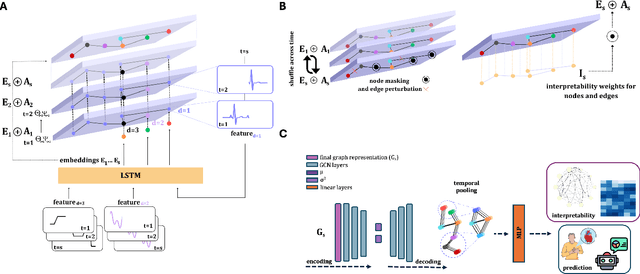
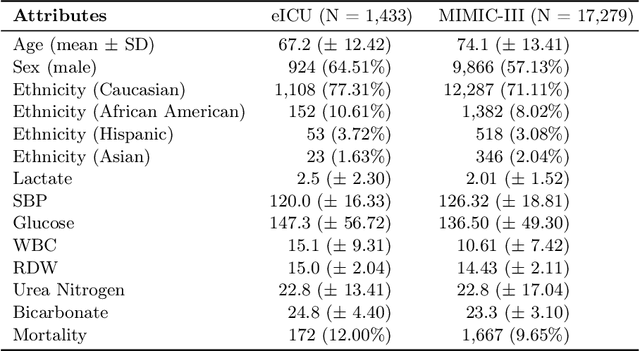
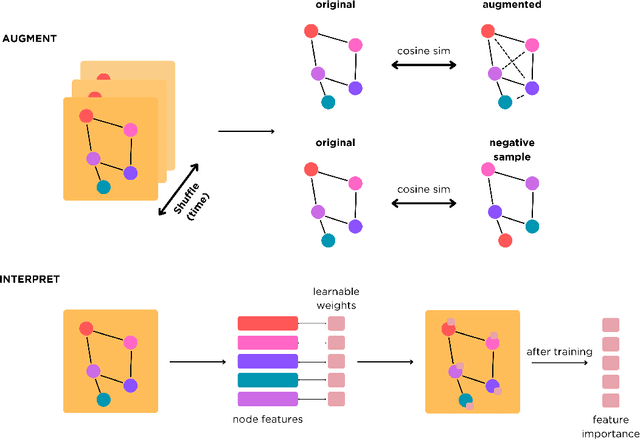

Abstract:Learning from longitudinal electronic health records is limited if it does not capture the temporal trajectories of the patient's state in a clinical setting. Graph models allow us to capture the hidden dependencies of the multivariate time-series when the graphs are constructed in a similar dynamic manner. Previous dynamic graph models require a pre-defined and/or static graph structure, which is unknown in most cases, or they only capture the spatial relations between the features. Furthermore in healthcare, the interpretability of the model is an essential requirement to build trust with clinicians. In addition to previously proposed attention mechanisms, there has not been an interpretable dynamic graph framework for data from multivariate electronic health records (EHRs). Here, we propose DynaGraph, an end-to-end interpretable contrastive graph model that learns the dynamics of multivariate time-series EHRs as part of optimisation. We validate our model in four real-world clinical datasets, ranging from primary care to secondary care settings with broad demographics, in challenging settings where tasks are imbalanced and multi-labelled. Compared to state-of-the-art models, DynaGraph achieves significant improvements in balanced accuracy and sensitivity over the nearest complex competitors in time-series or dynamic graph modelling across three ICU and one primary care datasets. Through a pseudo-attention approach to graph construction, our model also indicates the importance of clinical covariates over time, providing means for clinical validation.
AnchorInv: Few-Shot Class-Incremental Learning of Physiological Signals via Representation Space Guided Inversion
Dec 18, 2024



Abstract:Deep learning models have demonstrated exceptional performance in a variety of real-world applications. These successes are often attributed to strong base models that can generalize to novel tasks with limited supporting data while keeping prior knowledge intact. However, these impressive results are based on the availability of a large amount of high-quality data, which is often lacking in specialized biomedical applications. In such fields, models are usually developed with limited data that arrive incrementally with novel categories. This requires the model to adapt to new information while preserving existing knowledge. Few-Shot Class-Incremental Learning (FSCIL) methods offer a promising approach to addressing these challenges, but they also depend on strong base models that face the same aforementioned limitations. To overcome these constraints, we propose AnchorInv following the straightforward and efficient buffer-replay strategy. Instead of selecting and storing raw data, AnchorInv generates synthetic samples guided by anchor points in the feature space. This approach protects privacy and regularizes the model for adaptation. When evaluated on three public physiological time series datasets, AnchorInv exhibits efficient knowledge forgetting prevention and improved adaptation to novel classes, surpassing state-of-the-art baselines.
DTR-Bench: An in silico Environment and Benchmark Platform for Reinforcement Learning Based Dynamic Treatment Regime
May 28, 2024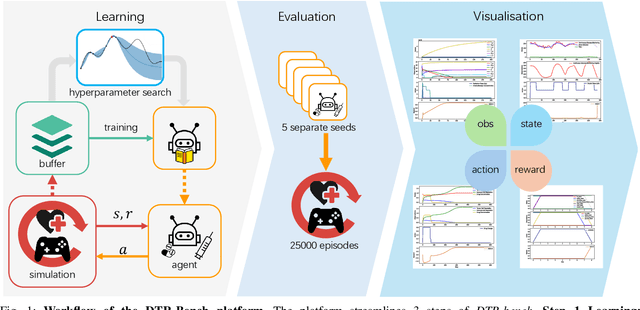
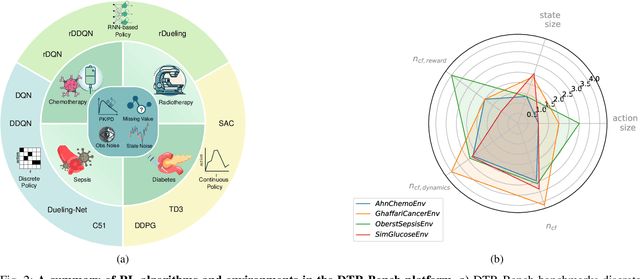


Abstract:Reinforcement learning (RL) has garnered increasing recognition for its potential to optimise dynamic treatment regimes (DTRs) in personalised medicine, particularly for drug dosage prescriptions and medication recommendations. However, a significant challenge persists: the absence of a unified framework for simulating diverse healthcare scenarios and a comprehensive analysis to benchmark the effectiveness of RL algorithms within these contexts. To address this gap, we introduce \textit{DTR-Bench}, a benchmarking platform comprising four distinct simulation environments tailored to common DTR applications, including cancer chemotherapy, radiotherapy, glucose management in diabetes, and sepsis treatment. We evaluate various state-of-the-art RL algorithms across these settings, particularly highlighting their performance amidst real-world challenges such as pharmacokinetic/pharmacodynamic (PK/PD) variability, noise, and missing data. Our experiments reveal varying degrees of performance degradation among RL algorithms in the presence of noise and patient variability, with some algorithms failing to converge. Additionally, we observe that using temporal observation representations does not consistently lead to improved performance in DTR settings. Our findings underscore the necessity of developing robust, adaptive RL algorithms capable of effectively managing these complexities to enhance patient-specific healthcare. We have open-sourced our benchmark and code at https://github.com/GilesLuo/DTR-Bench.
Reinforcement Learning in Dynamic Treatment Regimes Needs Critical Reexamination
May 28, 2024



Abstract:In the rapidly changing healthcare landscape, the implementation of offline reinforcement learning (RL) in dynamic treatment regimes (DTRs) presents a mix of unprecedented opportunities and challenges. This position paper offers a critical examination of the current status of offline RL in the context of DTRs. We argue for a reassessment of applying RL in DTRs, citing concerns such as inconsistent and potentially inconclusive evaluation metrics, the absence of naive and supervised learning baselines, and the diverse choice of RL formulation in existing research. Through a case study with more than 17,000 evaluation experiments using a publicly available Sepsis dataset, we demonstrate that the performance of RL algorithms can significantly vary with changes in evaluation metrics and Markov Decision Process (MDP) formulations. Surprisingly, it is observed that in some instances, RL algorithms can be surpassed by random baselines subjected to policy evaluation methods and reward design. This calls for more careful policy evaluation and algorithm development in future DTR works. Additionally, we discussed potential enhancements toward more reliable development of RL-based dynamic treatment regimes and invited further discussion within the community. Code is available at https://github.com/GilesLuo/ReassessDTR.
A Survey of Few-Shot Learning for Biomedical Time Series
May 03, 2024



Abstract:Advancements in wearable sensor technologies and the digitization of medical records have contributed to the unprecedented ubiquity of biomedical time series data. Data-driven models have tremendous potential to assist clinical diagnosis and improve patient care by improving long-term monitoring capabilities, facilitating early disease detection and intervention, as well as promoting personalized healthcare delivery. However, accessing extensively labeled datasets to train data-hungry deep learning models encounters many barriers, such as long-tail distribution of rare diseases, cost of annotation, privacy and security concerns, data-sharing regulations, and ethical considerations. An emerging approach to overcome the scarcity of labeled data is to augment AI methods with human-like capabilities to leverage past experiences to learn new tasks with limited examples, called few-shot learning. This survey provides a comprehensive review and comparison of few-shot learning methods for biomedical time series applications. The clinical benefits and limitations of such methods are discussed in relation to traditional data-driven approaches. This paper aims to provide insights into the current landscape of few-shot learning for biomedical time series and its implications for future research and applications.
Understanding Missingness in Time-series Electronic Health Records for Individualized Representation
Feb 24, 2024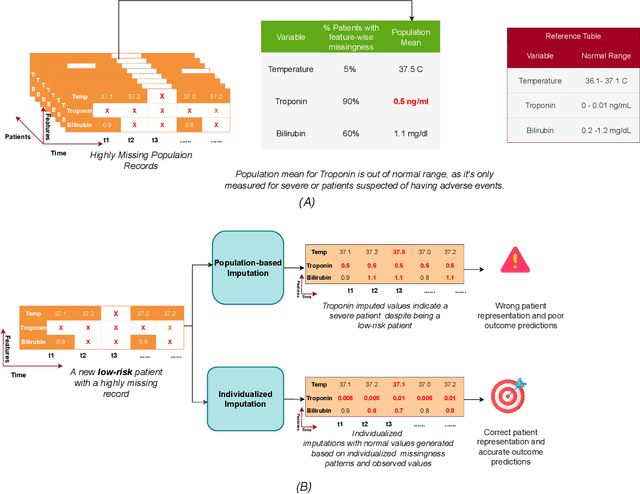
Abstract:With the widespread of machine learning models for healthcare applications, there is increased interest in building applications for personalized medicine. Despite the plethora of proposed research for personalized medicine, very few focus on representing missingness and learning from the missingness patterns in time-series Electronic Health Records (EHR) data. The lack of focus on missingness representation in an individualized way limits the full utilization of machine learning applications towards true personalization. In this brief communication, we highlight new insights into patterns of missingness with real-world examples and implications of missingness in EHRs. The insights in this work aim to bridge the gap between theoretical assumptions and practical observations in real-world EHRs. We hope this work will open new doors for exploring directions for better representation in predictive modelling for true personalization.
 Add to Chrome
Add to Chrome Add to Firefox
Add to Firefox Add to Edge
Add to Edge